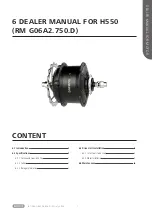
Marine Installation Manual
2021-08
4-45
4 Ancillary Systems
4.4 Fuel gas system
X72DF
Re-liquefaction process
An on-board re-liquefaction system recovers excess NBOG in the FGSS and re
-
turns it to the cargo tanks. This re-liquefaction process reduces the pressure in the
system without having to dispose the fuel gas through the GCU, which is also
known as NBOG flaring. This is important during voyages as well as in port, as
cargo tank pressure requirements must be met. The re-liquefaction of NBOG also
slows down the ‘LNG ageing’. LNG ageing means the reduction of the methane
content in the LNG composition, resulting in lowering the methane number.
There are two basic methods of cooling within a re-liquefaction plant. These
methods are often used in many different combinations, resulting in re-liquefac
-
tion of the NBOG. These two basic methods are described in detail below.
Cooling by the
Joule-Thompson effect
The Joule-Thompson effect is the change in temperature that is experienced by a
gas when subjected to a change in pressure. Within a re-liquefaction system, if
the NBOG from the tank is pressurised through a compressor, it will cause the
NBOG to heat up. If the NBOG is then again cooled before reducing its pressure
(by a release valve), then its temperature can fall below its boiling point. This will
cause the NBOG to partially return to liquid, while the rest remains gaseous, but
at the very cold boiling temperature. This cold boiling temperature is utilised in
the cooling process of the compressed NBOG.
Cooling by the
Reversed-Brayton effect
The alternative method for cooling is a refrigeration process where a heat ex
-
changer is able to remove enough heat from the NBOG, so that it falls below its
boiling point without any pressure changes. This is normally achieved by a ni
-
trogen cooling system which provides sufficient cooling capacity to the heat ex
-
changer. This principle is known as the Reversed-Brayton effect.
These two basic methods can be used together in different system configurations
to offer the best results and efficiency for re-liquefying the NBOG. After being
cooled, it must then be passed through a separator to remove any NBOG that has
not condensed. After this point, the NBOG which has not been condensed is
then normally recirculated back to the beginning of the re-liquefaction process,
while the LNG generated from the re-liquefaction process is then returned to the
LNG tank(s).
Sub-cooling method
The process of spraying sub-cooled LNG into the top of the tank is an alternative
approach for indirectly handling the NBOG. This method of managing the
system pressure is different compared to the direct handling of the NBOG. In
-
stead of returning the NBOG to its liquid state, a sub-cooler aims to continuously
cool the LNG below its boiling point, therefore preventing it from reaching its
boiling temperature. As seen in
, the LNG is pumped from
the tank and after sub-cooling it is returned back to the tank. The LNG is either
returned by spraying it from the top of the tank into the gas layer above the LNG
level, or by mixing it into the LNG in the tank. The process of spraying helps to
reduce the tank pressure.
















































